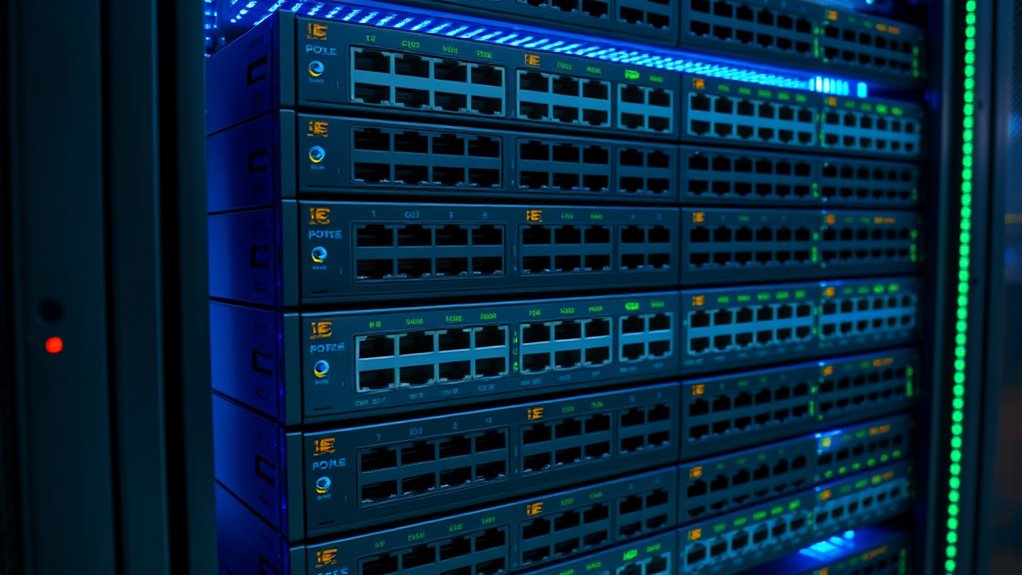I’ve researched the top PoE network switches of 2025 and found excellent options for different needs, from compact unmanaged models to powerful managed switches with high PoE budgets. Many feature durable, fanless designs for silent operation and long-lasting performance, supporting devices like cameras and access points at extended distances. They also offer various port configurations, management features, and safety certifications. If you keep exploring, you’ll discover all the factors to pick the perfect switch for your network.
Key Takeaways
- Consider switches with high PoE power budgets and long-distance transmission for extensive surveillance and device deployment.
- Prioritize models with durable, fanless metal cases and environmental protections for reliability and quiet operation.
- Look for managed switches supporting VLANs, QoS, and cloud management for enhanced network control and scalability.
- Ensure compatibility with IEEE 802.3af/at standards to support various PoE devices like cameras, phones, and access points.
- Evaluate certifications (UL, ETL, CE) and surge protection features to ensure safety, compliance, and long-term performance.
TP-Link TL-SG1005P 5-Port Gigabit PoE Switch
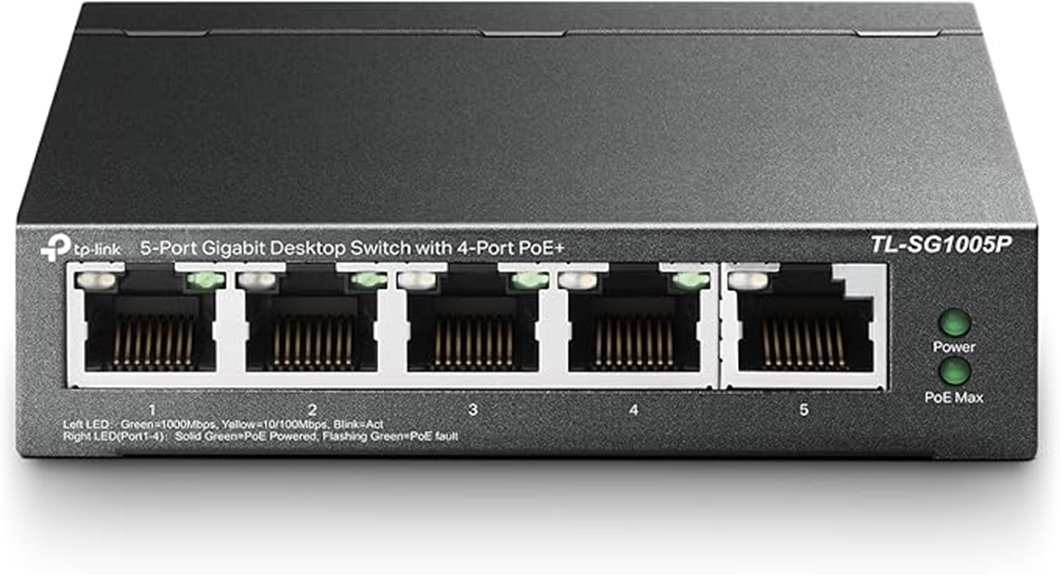
If you’re looking for a reliable, easy-to-use Poe switch suitable for small to medium deployments, the TP-Link TL-SG1005P stands out. It’s a compact, 5-port gigabit switch with 4 PoE+ ports, each delivering up to 30W, and a total budget of 65W. Its sturdy metal case and fanless design guarantee quiet operation, perfect for office or home use. With plug-and-play setup, auto-negotiation, and features like Extend Mode, it simplifies powering devices like cameras and access points over long distances. Many users praise its durability, performance, and reliability, making it a top choice for expanding network capabilities easily and efficiently.
Best For: small to medium-sized offices or home networks that need a reliable, easy-to-use PoE switch for powering security cameras, access points, and other network devices.
Pros:
- Compact and sturdy metal design with fanless operation for silent performance
- Supports up to 4 PoE+ devices with a total power budget of 65W, suitable for multiple devices
- Plug-and-play setup with auto-negotiation and Extend Mode for long-distance PoE transmission
Cons:
- Lacks advanced management features like SNMP, limiting control for larger or more complex networks
- Slightly higher price point compared to similar unmanaged switches without PoE+
- Heats up near upper temperature limits (+40°C), requiring proper placement to prevent overheating
NETGEAR 8 Port PoE Gigabit Ethernet Switch

The NETGEAR GS308EP stands out as an excellent choice for small to medium businesses seeking a reliable, easy-to-manage PoE switch. It offers 8 gigabit ports, all supporting PoE+ with a total power budget of 62W—perfect for powering IP cameras, VoIP phones, and access points. Its compact design allows desktop or wall mounting, and it operates silently, making it suitable for noise-sensitive environments. The switch features user-friendly Easy Smart management software, enabling simple VLAN and PoE controls, though VLAN configuration can be a bit cumbersome. Customers praise its affordability, reliability, and plug-and-play setup, making it a solid investment for small network deployments.
Best For: small to medium businesses seeking an affordable, reliable PoE switch with easy management and silent operation.
Pros:
- Easy plug-and-play setup with intuitive web-based management software.
- Supports PoE+ on all ports, ideal for powering IP cameras and VoIP phones.
- Compact, silent design suitable for desktop or wall mounting in noise-sensitive environments.
Cons:
- VLAN configuration can be somewhat cumbersome and less intuitive.
- Limited PoE power budget of 62W may restrict high-power device deployment.
- No CLI access for advanced management or scripting options.
TP-Link TL-SF1005P 5-Port Fast Ethernet PoE Switch
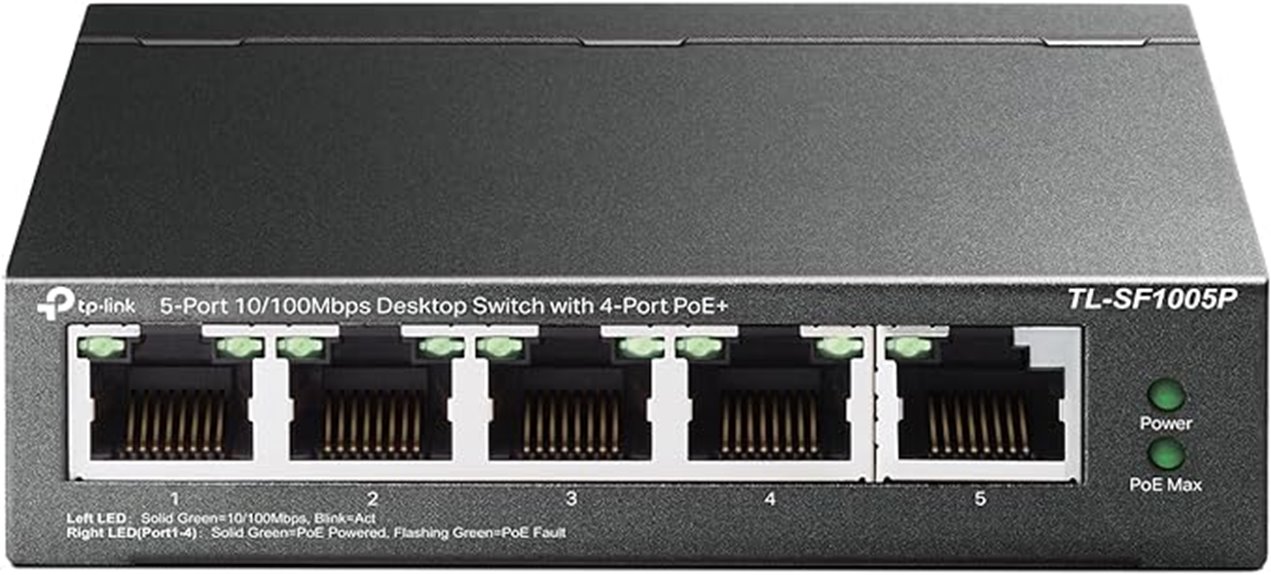
For small businesses and home users seeking a reliable and budget-friendly PoE switch, the TP-Link TL-SF1005P stands out with its straightforward design and efficient power delivery. It offers 4 PoE+ ports delivering up to 30W each, with a total PoE budget of 67W, plus an extra non-PoE port for stable connections. Its sturdy metal casing, compact size, and fanless operation make it perfect for desktop or wall mounting. Setup is plug-and-play, requiring no software. It supports features like Extend Mode for long-distance data and power transmission, making it an excellent choice for surveillance cameras and small networks.
Best For: small businesses and home users looking for a reliable, budget-friendly PoE switch for network expansion and surveillance applications.
Pros:
- Easy plug-and-play setup with no software required
- Compact, sturdy metal casing suitable for desktop or wall mounting
- Supports Extend Mode for long-distance data and power transmission up to 250 meters
Cons:
- Limited to 4 PoE+ ports, which may be insufficient for larger setups
- Fanless design, while quiet, may impact cooling in high-temperature environments
- Requires compatible PoE-powered devices to fully utilize PoE features
TP-Link LS108GP 8-Port PoE Gigabit Ethernet Switch

Designed for small to medium-sized networks, the TP-Link LS108GP stands out with its 8 PoE+ ports that deliver up to 30W per port, making it an ideal choice for surveillance, IP phones, and wireless access points. It offers a total PoE power budget of 65W and a 16 Gbps switching capacity for fast data transfer. Its plug-and-play setup requires no configuration, and Extend Mode allows PoE transmission up to 820 feet. Built with a fanless, sturdy metal case, it operates silently and fits easily on desktops or walls. Overall, the LS108GP combines reliability, ease of use, and efficient power delivery for diverse network needs.
Best For: small to medium-sized businesses or home offices needing reliable, cost-effective PoE network expansion for surveillance, IP phones, and wireless access points.
Pros:
- Easy plug-and-play setup with no configuration required
- Supports high power output per port (up to 30W) and extended PoE transmission up to 820 feet
- Quiet, fanless design with durable metal casing suitable for desktop or wall mounting
Cons:
- Limited total PoE power budget of 65W may restrict multiple high-power devices
- No advanced management features or network configuration options
- Slight fan noise reported in some environments, though generally minimal
NETGEAR 5-Port PoE Gigabit Ethernet Switch (GS305P)

If you’re looking for an affordable, reliable PoE switch for small networks, the NETGEAR GS305P stands out as an excellent choice. It offers 5 Gigabit ports, including 4 PoE+ ports with a total 63W power budget, perfect for powering IP cameras, access points, or smart devices. Its plug-and-play setup means no software or configuration is needed, making installation quick and straightforward. Designed for desktop or wall mounting, it operates silently and efficiently, complying with energy standards. Users praise its durability, stable gigabit speeds, and ease of use, making it ideal for both home and professional environments where dependable PoE power is essential.
Best For: small network setups requiring reliable gigabit connectivity with PoE support for IP cameras, access points, and smart devices in home or professional environments.
Pros:
- Easy plug-and-play setup with no software or configuration needed
- Reliable gigabit speeds suitable for high data throughput
- Compact, silent design ideal for noise-sensitive spaces and portable installations
Cons:
- Limited to 5 ports, which may not be sufficient for larger networks
- No managed features or VLAN support for advanced network segmentation
- Limited to the U.S. and Canada, restricting international use
TP-Link TL-SG108PE 8-Port Gigabit PoE Switch

The TP-Link TL-SG108PE 8-Port Gigabit PoE Switch stands out as an excellent choice for small networks and home offices seeking reliable, plug-and-play PoE connectivity. It features 8 gigabit ports, with 4 supporting PoE+ (up to 30W per port) and a total power budget of 64W. Its easy web-based management, VLAN support, and QoS features make network segmentation simple. Built with a sturdy metal case and fanless design, it operates silently and reliably. Users appreciate its straightforward setup, consistent performance, and ability to power devices like cameras and phones over short distances, making it ideal for small-scale PoE deployments.
Best For: small networks, home offices, and SOHO environments seeking reliable plug-and-play PoE connectivity and network segmentation.
Pros:
- Easy plug-and-play setup with no software installation required
- Supports PoE+ on four ports with up to 30W per port, ideal for powering devices like cameras and VoIP phones
- Durable metal housing with a fanless design for silent operation and enhanced reliability
Cons:
- Limited management features, lacking advanced monitoring and configuration options
- PoE is only supported on four ports, not all eight
- Maximum uplink speed is 100Mbps, which may bottleneck higher-speed network connections
TP-Link TL-SG116P 16-Port Gigabit PoE Switch

For small businesses and home networks needing reliable Power over Ethernet in a compact, easy-to-install package, the TP-Link TL-SG116P 16-Port Gigabit PoE Switch stands out. It offers 16 gigabit ports, each supporting PoE+ with up to 30W per port and a total power budget of 120W. Its plug-and-play setup makes installation straightforward, and features like QoS, IGMP snooping, and a fanless design ensure silent operation and high performance. Built with a durable metal case and operating at 57V DC, it’s perfect for powering access points, cameras, and other PoE devices, delivering speed, reliability, and ease of use.
Best For: small businesses and home users seeking a reliable, easy-to-install PoE switch for powering access points, cameras, and other network devices.
Pros:
- Plug-and-play setup for quick installation without complex configuration
- Supports PoE+ with up to 30W per port and a total power budget of 120W
- Silent, fanless operation with durable metal construction for reliable performance
Cons:
- Limited to 16 ports, which may not suffice for larger networks
- Only operates at 57V DC, requiring compatible power sources
- Some users report compatibility issues with certain PoE devices
NETGEAR 16-Port PoE+ Gigabit Ethernet Switch

Designed for small businesses and home networks, the NETGEAR GS316PP stands out with its 16 PoE+ ports and high-power 183W budget, making it ideal for powering multiple VoIP phones, security cameras, and wireless access points without the need for complex configuration. Its plug-and-play setup requires no software installation, and the silent, fanless design suits noise-sensitive spaces. Built with a durable metal case and supporting IEEE802.3az energy efficiency standards, it offers reliable gigabit connectivity. The switch automatically balances power across ports using NETGEAR’s FlexPoE technology, ensuring devices receive adequate power without overloads. It’s a compact, cost-effective solution for small-scale network expansion.
Best For: small businesses and home networks seeking a reliable, easy-to-install PoE+ switch to power security cameras, VoIP phones, and wireless access points.
Pros:
- Plug-and-play setup with no software or configuration required
- Silent, fanless design suitable for noise-sensitive environments
- Supports IEEE802.3az energy efficiency standards for power savings
Cons:
- Does not support 24V passive PoE or 802.3af/A standards, limiting compatibility with some devices
- Overloading PoE budget can cause ports to turn off, requiring careful device connection management
- Customer support experience varies, with some users reporting difficulties with online registration and support cases
8 Port Gigabit PoE Switch with 2 Gigabit Uplink
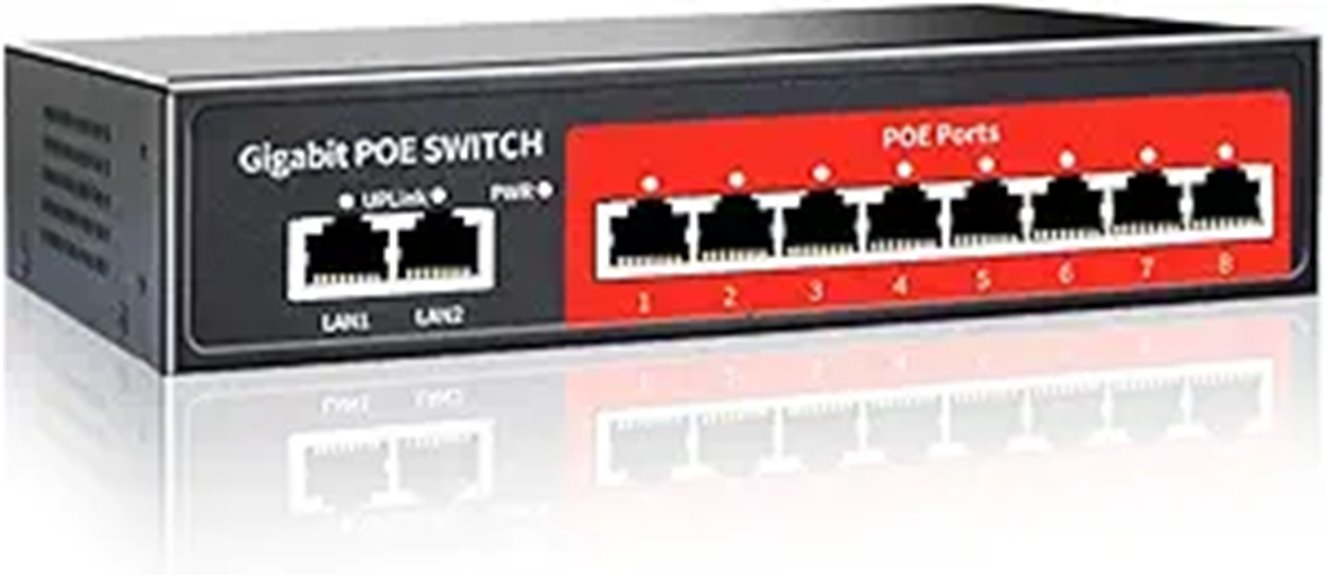
If you’re setting up a small to medium-sized network that demands reliable gigabit speeds and easy expandability, a port gigabit PoE switch with 2 gigabit uplink ports is an excellent choice. This unmanaged switch features 8 PoE ports supporting 802.3af/at, delivering up to 30W per port, perfect for cameras and access points. Its built-in power supply, fanless design, and network cable protection make it durable and silent. With a data transfer rate of 1,000 Mbps and two uplink ports, it offers straightforward plug-and-play installation, making it ideal for expanding security or Wi-Fi systems without complicated setup.
Best For: small to medium-sized businesses or home networks needing reliable gigabit PoE connectivity for security cameras, access points, and other PoE devices.
Pros:
- Supports 8 PoE ports with 802.3af/at compliance, delivering up to 30W per port for high-power devices
- Plug-and-play setup with a durable metal case and fanless design for silent operation
- Built-in power supply with network cable short-circuit protection and robust environmental protections
Cons:
- Lacks UL or ETL safety certifications, which may raise safety and fire risk concerns
- Limited testing of actual gigabit throughput, potentially affecting performance expectations
- Some users monitor long-term reliability and consider it a cost-effective but uncertified option
Ubiquiti UniFi Flex Mini 5-Port PoE Switch

Looking for a compact, budget-friendly PoE switch that seamlessly integrates into your small network? The Ubiquiti UniFi Flex Mini 5-Port PoE Switch is perfect. It offers five Gigabit Ethernet ports, with one supporting PoE, making it ideal for small offices or home setups. Managed via the UniFi Network Controller, it’s easy to configure and monitor remotely. Its small size allows flexible placement, and it supports VLANs and port isolation for enhanced network control. Despite its limited PoE ports and lack of mounting options, users praise its affordability, reliable performance, and straightforward setup, making it a smart choice for expanding small networks efficiently.
Best For: small home or office users seeking an affordable, compact PoE switch with easy management and reliable gigabit connections.
Pros:
- Compact design ideal for limited space environments
- Seamless integration with UniFi ecosystem for centralized control
- Supports VLANs and port isolation for enhanced network management
Cons:
- Limited to only one PoE port with no PoE passthrough
- Cannot be mounted with screws, restricting placement options
- May require a factory reset for initial device discovery in some setups
5-Port Ethernet PoE Switch with Extend Function

The Port Ethernet PoE Switch with Extend Function is ideal for those needing to power devices over long distances without sacrificing performance. It features 4 PoE ports—two gigabit and two fast Ethernet—and a dedicated uplink, compliant with IEEE802.3af/at standards, delivering up to 30W per port. Its compact, fanless metal design guarantees durability, and the built-in industrial power supply boosts reliability. With Ethernet transmission distances up to 250 meters, it’s perfect for IP cameras, access points, or security setups requiring extended reach. The switch supports remote management, VLAN, QoS, and surge protection, making it a dependable, versatile choice for long-distance, high-power network deployments.
Best For: small to medium-sized businesses or home security setups requiring long-distance, high-power PoE device deployment with easy management.
Pros:
- Supports long Ethernet transmission distances up to 250 meters, ideal for extended setups.
- Compact, durable, fanless metal housing ensures silent operation and robust performance.
- Enables remote management with advanced networking features like VLAN and QoS for flexible network control.
Cons:
- Requires compatible PoE devices or additional power splitters for passive PoE devices.
- Some users may have security concerns related to cyber threats if network security is not properly configured.
- Limited to 5 ports, which may not suit larger or growing network needs.
DBIT 6-Port Ethernet PoE Switch with PoE+ and Uplink
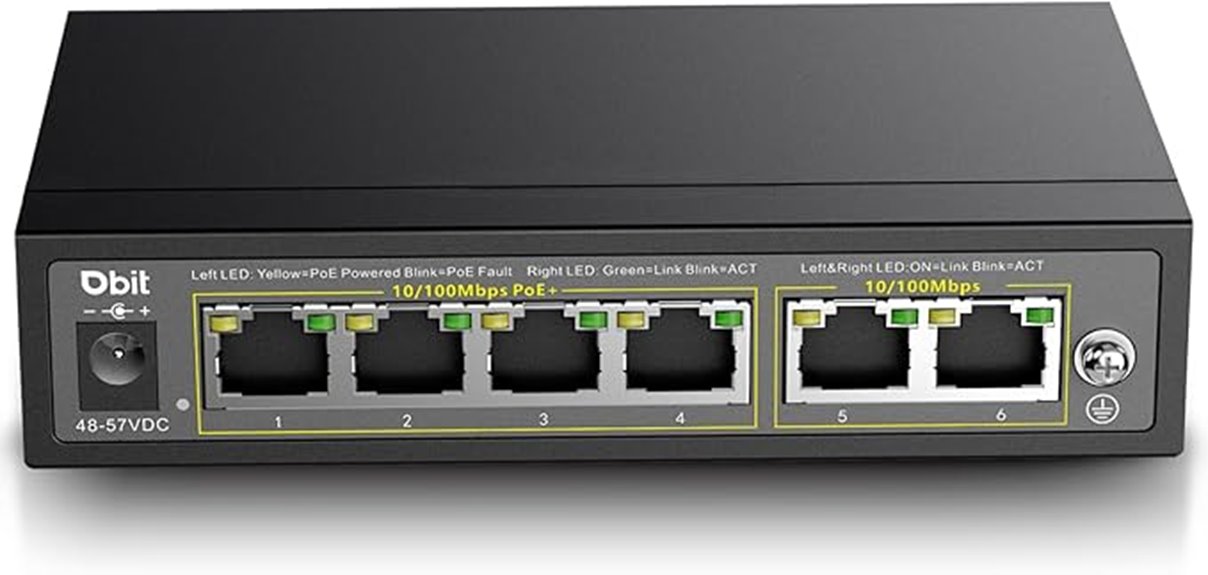
The DBIT 6-Port Ethernet PoE Switch with PoE+ and Uplink stands out as an ideal choice for small-scale surveillance setups and home network expansions. It offers four PoE+ ports delivering up to 30W each, with a total budget of 63W, perfect for powering IP cameras, phones, and access points. Its two Gigabit uplink ports ensure fast connections to other network devices or fiber optics via SFP slots. The fanless metal design guarantees durability and silent operation, while its plug-and-play setup simplifies installation. With high customer ratings, reliable performance, VLAN support, and flexible mounting options, this switch provides a cost-effective, efficient solution for expanding and securing your network.
Best For: small-scale surveillance systems, home network expansions, and office setups requiring reliable PoE power and gigabit uplinks.
Pros:
- Supports four PoE+ ports delivering up to 30W each, suitable for high-power devices
- Two Gigabit uplink ports and SFP slots for long-distance fiber connections
- Fanless metal design ensures durability, silent operation, and efficient heat dissipation
Cons:
- Total PoE budget of 63W may limit the number of high-power devices connected simultaneously
- Supports only 10/100Mbps speeds on regular ports, which may be limiting for high-bandwidth applications
- Cannot operate in both normal switching mode and VLAN mode simultaneously
Tenda TEG1105P 5-Port Gigabit PoE Switch

If you’re setting up a small office or home network with limited space, the Tenda TEG1105P offers a compact, plug-and-play solution that’s both reliable and easy to install. Its 5-port Gigabit design supports IEEE 802.3af/at PoE, delivering up to 58W across four ports, perfect for powering WiFi access points, cameras, and IP phones. The fanless, metal casing ensures quiet operation and durability, while its simple unmanaged setup makes deployment effortless. With features like VLAN support, lightning protection, and surge safeguards, it’s an excellent choice for small networks needing reliable PoE power in tight spaces.
Best For: small offices or home networks seeking a compact, reliable, and easy-to-install PoE switch for powering cameras, access points, and IP phones.
Pros:
- Simple plug-and-play setup with no configuration required
- Compact design ideal for tight spaces and wall mounting
- Supports VLAN, surge protection, and PoE standards for flexible and secure network deployment
Cons:
- Limited to 4 PoE ports, which may restrict device connectivity in larger setups
- No advanced management features or remote configuration options
- Power budget of 58W may be insufficient for multiple high-power PoE devices simultaneously
NETGEAR 52-Port PoE Gigabit Ethernet Switch (GS752TP)

For network professionals seeking a scalable, managed switch with extensive PoE support, the NETGEAR GS752TP stands out as a top choice. It offers 48 Gigabit Ethernet ports, including 48 PoE+ ports with a total power budget of 380W, perfect for powering IP cameras, VoIP phones, and wireless access points. The switch includes 4 fiber SFP ports for flexible connectivity and supports cloud management via Insight for easy setup and monitoring. Its energy-efficient design complies with IEEE802.3az standards, and it’s suitable for rack or desktop deployment. With a lifetime warranty and 24/7 support, the GS752TP delivers reliable performance for demanding network environments.
Best For: network professionals and organizations needing a scalable, managed switch with extensive PoE support for powering IP devices and fiber connectivity.
Pros:
- 48 PoE+ ports with a high total power budget of 380W, suitable for multiple PoE devices
- Support for cloud management via Insight for easy setup and remote monitoring
- Energy-efficient design compliant with IEEE802.3az standards, reducing power consumption
Cons:
- Customer reports of PoE power failures and network communication issues
- Outdated firmware and limited support for some older units
- Higher price point compared to unmanaged or less feature-rich switches
Factors to Consider When Choosing PoE Network Switches

When selecting a PoE network switch, I consider factors like power budget capacity to guarantee it supports all connected devices. I also evaluate the port count and whether I need managed or unmanaged options for easier control. Additionally, I check transmission distance limits and build quality standards to ensure reliability and future-proofing.
Power Budget Capacity
The power budget capacity of a PoE switch defines the total wattage available to all its ports, directly impacting how many devices it can support simultaneously. This capacity determines the maximum power that can be delivered across connected devices like VoIP phones, cameras, or access points. A higher overall power budget allows you to support more devices or higher-power devices without risking overloads. It’s essential to match the switch’s total wattage with your network’s specific device requirements to avoid outages or insufficient power. Some switches include features like extend mode or auto-recovery, which help manage power distribution efficiently, especially over long distances or complex setups. Choosing a switch with an appropriate power budget ensures reliable operation and future scalability.
Port Count Options
Choosing the right port count for a PoE switch depends on your current device needs and future growth plans. Smaller switches with 5 to 8 ports are perfect for compact setups or home use, where fewer devices need power and connectivity. For small to medium-sized networks, switches with 16 or more ports offer the capacity to connect multiple devices like cameras, access points, and VoIP phones. Larger switches with 24 or 48 ports are ideal for extensive deployments, such as office buildings or security systems, ensuring room for expansion. Keep in mind that higher port counts often come with additional features like VLAN support and fiber uplinks. Balancing your current requirements with anticipated growth helps you choose a switch that’s scalable, functional, and cost-effective.
Managed Vs Unmanaged
Deciding between managed and unmanaged PoE switches hinges on your network’s complexity and the level of control you need. Managed switches offer advanced features like VLAN setup, QoS, and port monitoring, which are essential for larger, segmented networks. They require configuration via a web interface or software, but provide remote firmware updates and troubleshooting, giving you greater control over performance and security. Unmanaged switches, on the other hand, work straight out of the box with plug-and-play simplicity, making them ideal for small, straightforward setups. If your network demands scalability, traffic management, and security, managed switches are the way to go. For simpler environments, unmanaged switches provide a cost-effective, hassle-free solution. Your choice ultimately depends on your current and future network needs.
Transmission Distance Limits
Understanding transmission distance limits is essential when selecting PoE network switches, as it directly impacts your network’s layout and performance. The standard maximum for Ethernet cables is 100 meters (328 feet), but this can vary based on cable quality, gauge, and environmental factors. Higher-quality cables can prolong this distance, while poor cables may reduce it. For longer runs, PoE extenders, repeaters, or fiber optic conversions are often necessary to ensure reliable power and data transmission. In some cases, “Extend Mode” allows PoE to reach up to 820 feet (250 meters) at reduced speeds, mainly for surveillance cameras. Being aware of these limits helps you plan your network efficiently, avoiding signal attenuation, voltage drops, and compromised performance.
Build Quality Standards
Build quality standards play a essential role in ensuring the reliability and safety of PoE network switches. Certifications like UL, ETL, or CE indicate that the switch meets industry safety and compliance regulations, giving you peace of mind. A sturdy metal casing often signals better durability and heat dissipation compared to plastic enclosures, which is key for long-term performance. Fanless designs provide silent operation and help reduce dust intake, boosting longevity and reliability. Surge protection features, such as lightning protection up to 4KV or 6KV, safeguard connected devices and maintain network stability during electrical storms. Additionally, high-quality switches typically undergo rigorous testing for temperature tolerance, vibration, and electrical interference, ensuring consistent performance over time. Prioritizing build quality standards helps you choose a dependable, safe, and durable PoE switch.
Compatibility With Devices
How do you guarantee your PoE network switch works seamlessly with your devices? First, ensure it supports IEEE 802.3af/at standards, which are widely compatible with IP cameras, phones, and access points. Check the power budget per port and total capacity to confirm it can handle your devices without overload. Also, verify if the switch supports active PoE, offering better compatibility and safety compared to passive PoE. Matching port types and speeds—like gigabit or fast Ethernet—is essential for smooth data transfer. Additionally, consider device-specific needs, especially for specialized equipment from brands like Ubiquiti or Cisco. Reviewing manufacturer datasheets helps confirm your switch supports the necessary standards and power levels, making integration straightforward and reliable.
Installation and Placement
Choosing the right PoE network switch involves considering how and where you’ll install it to guarantee peak performance and convenience. Think about whether you need wall-mounting options or a desktop setup, depending on your space. Check the switch’s size and weight to make sure it fits comfortably, especially in tight or elevated areas. Look for mounting brackets or dedicated options for secure installation. Also, verify the operating temperature range to prevent overheating, especially if you plan to install it outdoors or in enclosed spaces. Finally, confirm the switch’s power and port configuration match your device placement and cable routing needs. Proper placement and installation help maximize performance, simplify maintenance, and guarantee long-term reliability of your network.
Frequently Asked Questions
How Does Poe Switch Capacity Affect Network Scalability?
When I consider how PoE switch capacity affects network scalability, I realize that higher port counts and power budgets enable me to add more devices without upgrading the entire network. A switch with ample capacity allows for seamless expansion, supporting future growth and new tech integrations. This flexibility means I can confidently scale my network as my needs grow, knowing the switch can handle increased traffic and power demands efficiently.
What Safety Features Are Essential in Poe Switches?
When considering Poe switches, safety features are essential for protecting both devices and users. I look for features like surge protection, overload shutdown, and automatic port shutoff to prevent damage from power surges or faults. Additionally, having built-in alarms or alerts helps me monitor the switch’s health, ensuring my network remains reliable and secure. These safety measures give me peace of mind, knowing my equipment is protected from potential electrical issues.
How Does Switch Port Speed Impact Overall Network Performance?
You might think port speed doesn’t matter much, but it really impacts your network’s performance. Faster port speeds mean data transfers happen quickly, reducing lag and bottlenecks. If your switch ports are slow, they can hold back your entire network, especially with multiple devices. Upgrading to higher speeds guarantees smoother streaming, better VoIP quality, and faster file sharing. So, choosing the right port speed is essential for a reliable, efficient network.
Can Existing Network Infrastructure Integrate With New Poe Switches?
You’re wondering if your current network infrastructure can work with new PoE switches. I’ve found that compatibility depends on your existing hardware’s standards and port speeds. If your switches support the same protocols and power requirements, integration is usually smooth. Sometimes, an upgrade might be necessary for older equipment. I recommend evaluating your current setup and consulting the switch’s specifications to guarantee seamless compatibility and ideal performance.
What Are the Energy Efficiency Considerations for Poe Switches?
When considering energy efficiency for PoE switches, I focus on models with Energy-Efficient Ethernet (EEE) support, which reduces power when network traffic is low. I also look for switches that automatically adjust power based on device requirements, preventing waste. Using switches with high efficiency ratings helps save energy and lowers operational costs. Overall, choosing devices designed with energy conservation in mind benefits both the environment and my budget.
Conclusion
No matter which PoE switch you pick, it’s clear that investing in quality hardware is key to keeping your network running smoothly. Remember, a chain is only as strong as its weakest link, so don’t cut corners. By choosing a reliable switch, you’ll set yourself up for seamless connectivity and future growth. Ultimately, it’s better to be safe than sorry—after all, you don’t want to be caught with your pants down when things go south.
